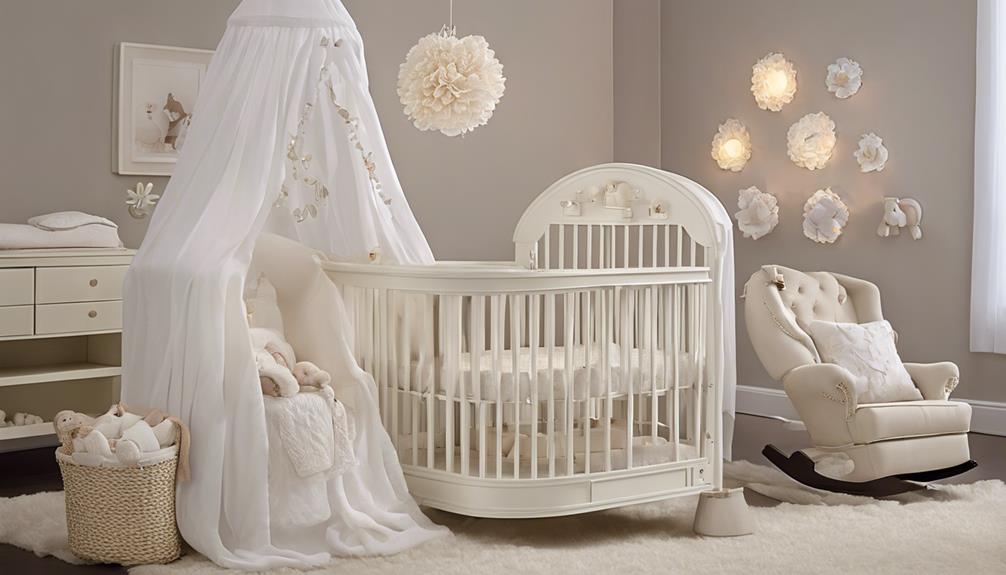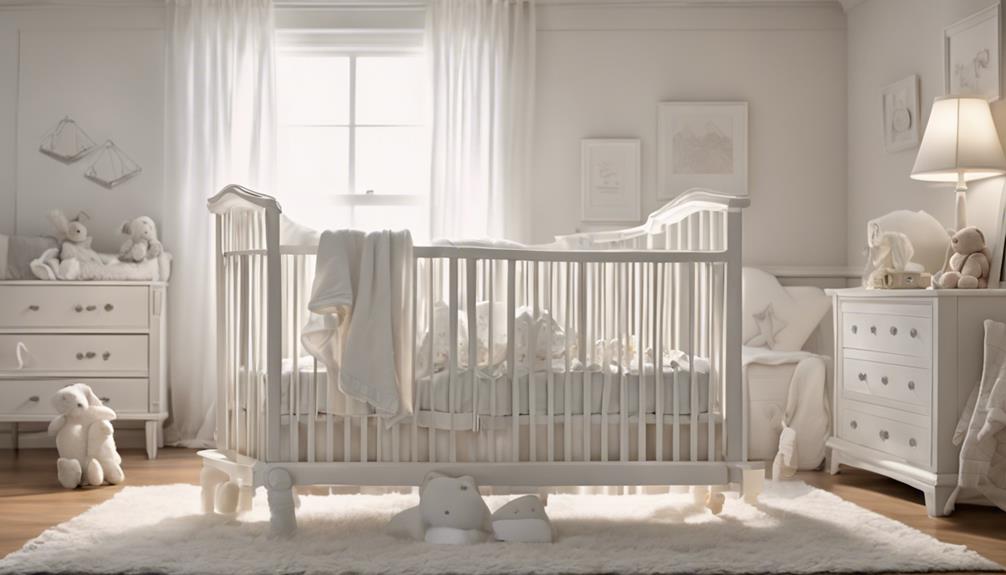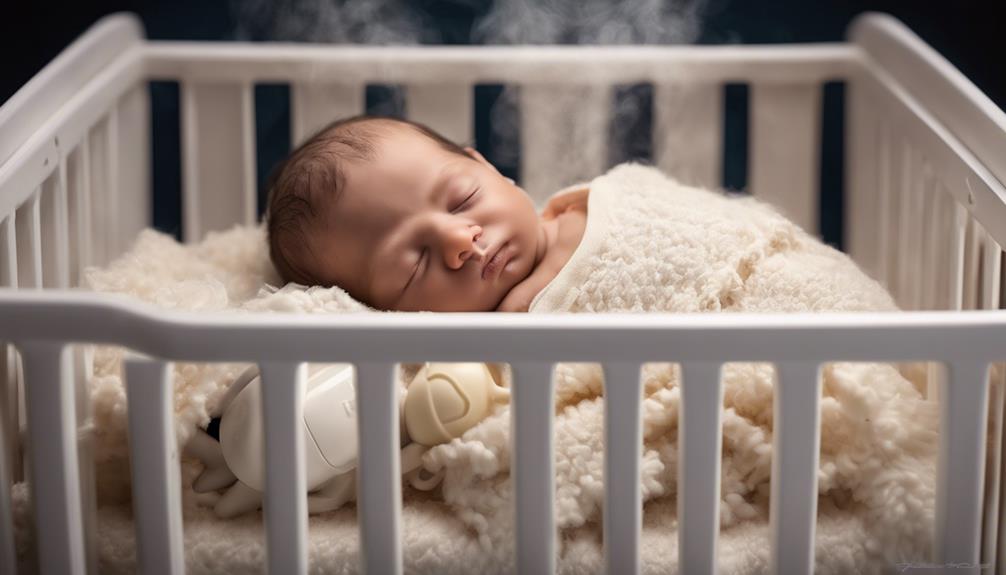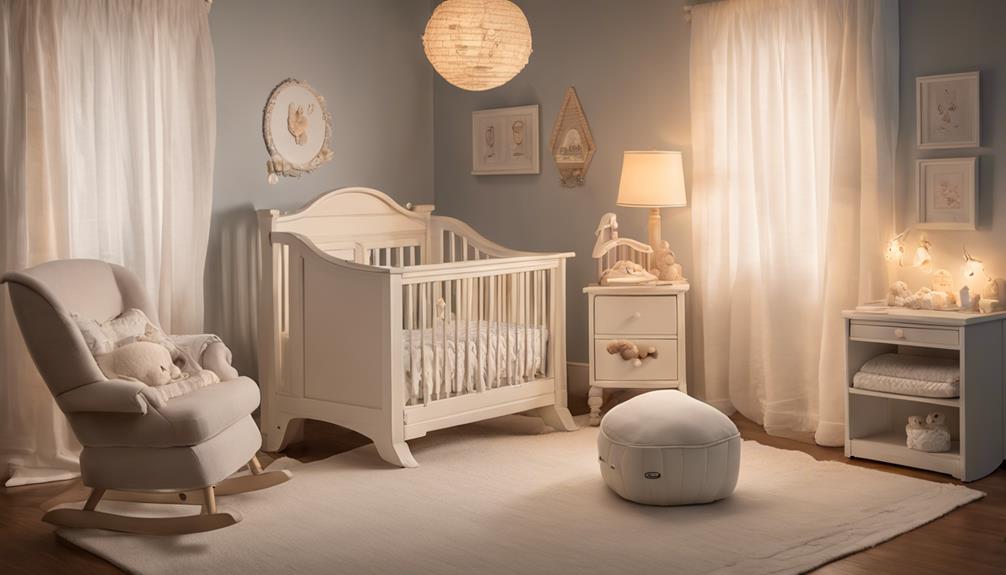When our daughter, Emily, was born, we had a hard time getting her to sleep in the bassinet until we found some key strategies that really helped.
Implementing these techniques not only helped Emily sleep more soundly but also gave us much-needed rest.
If you're looking for ways to guarantee your newborn sleeps peacefully in a bassinet, stay tuned for practical tips and insights that can transform your nighttime routine.
Key Takeaways
- Ensure a safe sleep environment in the bassinet following SIDS prevention guidelines.
- Address newborn sleep challenges like startle reflex and discomfort for better rest.
- Implement techniques like swaddling and white noise for sound sleep.
- Establish a consistent bedtime routine to promote peaceful sleep habits.
Why Babies Sleep in Bassinets
Babies sleep in bassinets for their safety and well-being, adhering to safe sleep guidelines important for reducing the risk of Sudden Infant Death Syndrome (SIDS). The bassinet offers a firm surface, recommended by the American Academy of Pediatrics, providing newborns with a secure sleeping environment. Room-sharing with a bassinet enables caregivers to closely monitor the baby during sleep, fostering a sense of security without the dangers associated with bed-sharing. These guidelines prioritize the elimination of suffocation hazards like loose bedding, pillows, and soft surfaces, ensuring a safe sleep space conducive to the newborn's well-being.
As the baby grows, shifting from the bassinet to a crib around 4-6 months maintains a consistent and safe sleep environment. This seamless change supports the baby's evolving needs while upholding the principles of safe sleep practices. By following these guidelines and creating a secure sleep environment, caregivers can promote healthy sleep habits for their newborns, fostering a sense of comfort and protection throughout the night.
Common Sleep Challenges for Newborns

When newborns face common sleep challenges in bassinets, it can be distressing for both caregivers and babies alike. Here are some of the difficulties newborns may encounter:
- The startle reflex: This sudden jerking movement can startle babies awake, disrupting their sleep cycles.
- Overtiredness: When newborns become overtired, they may find it harder to settle down and fall asleep peacefully.
- Discomfort: Lack of proper support in a bassinet can lead to discomfort for newborns, making it challenging for them to sleep soundly.
It's heartbreaking to see our little ones struggle with these issues, but there are ways to help them overcome these obstacles. Providing extra support in the bassinet, addressing gassiness or reflux problems, and implementing soothing strategies can make a significant difference. By understanding and tackling these sleep challenges, we can create a more peaceful and restful environment for our precious newborns.
Creating a Safe Sleep Environment

To guarantee a safe sleep environment for your newborn in the bassinet, positioning the firm mattress correctly is essential. A firm mattress without gaps guarantees a safe sleeping surface for your baby, reducing the risk of SIDS.
It's important to follow AAP guidelines by placing the bassinet in your room, maintaining a room temperature between 68-72°F. Avoid using soft bedding, blankets, or pillows in the bassinet to prevent suffocation hazards.
Remember to always position your newborn on their back to sleep, promoting safe sleep practices. By creating a safe sleep environment in the bassinet, you provide your little one with the best conditions for a sound and restful sleep.
Your baby's safety and well-being are our top priorities, so follow these tips to ensure a peaceful slumber for your precious newborn.
Techniques to Help Newborns Sleep

Incorporating swaddling into your newborn's sleep routine can promote a sense of security and help prevent disruptions caused by the startle reflex. Swaddling mimics the snug environment of the womb, comforting your baby to sleep peacefully in the bassinet. Here are some techniques to help your newborn drift off to dreamland:
- Using a white noise machine: The gentle hum of a white noise machine can create a soothing environment, masking other sounds that might startle your baby awake.
- Establishing a consistent bedtime routine: Dimming the lights, reading a bedtime story, or playing soft music can signal to your baby that it's time to sleep, helping them settle down in the bassinet.
- Introducing the scent of a parent: Placing an item of clothing with your scent near your baby in the bassinet can provide reassurance and familiarity, helping them feel secure as they doze off.
Importance of Establishing a Bedtime Routine

Establishing a bedtime routine with your newborn can greatly enhance their sleep quality and overall sense of security. Creating a consistent schedule helps signal to your little one that it's time to rest, reducing bedtime resistance and promoting a peaceful sleep environment. Bedtime rituals like a warm bath, gentle massage, or soothing lullabies can calm your newborn, preparing them for a restful night in the bassinet. Research indicates that babies following a bedtime routine tend to fall asleep faster and experience more rejuvenating sleep. By incorporating cues such as dimming lights and creating a quiet atmosphere during this routine, you can set ideal conditions for your newborn to sleep soundly. Remember, each baby is unique, so feel free to adjust the routine to suit your child's needs. Here's a helpful table outlining the importance of a bedtime routine:
| Benefits of Bedtime Routine |
|---|
| Promotes consistent sleep schedule |
| Reduces bedtime resistance |
| Creates a calming environment |
Can the Tips for Getting Newborns to Sleep in a Bassinet Also Work for Newborns Who Won’t Sleep?
When it comes to tips for newborn sleep, getting a newborn to sleep in a bassinet can be a challenge. However, the same tips can be used for newborns who won’t sleep. Consistency, swaddling, and white noise can help create a calming environment for all newborns to sleep soundly.
Conclusion
As new parents, we grasp the challenges of getting your newborn to sleep soundly in a bassinet. By creating a safe sleep environment, using soothing techniques, and establishing a bedtime routine, you can help your little one drift off peacefully.
Remember, consistency is key in promoting healthy sleep habits for your baby. With patience and care, you'll soon find that your newborn is sleeping soundly in their bassinet, allowing you to rest easier too.










